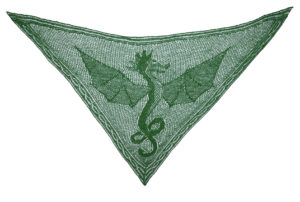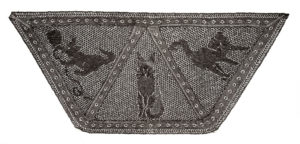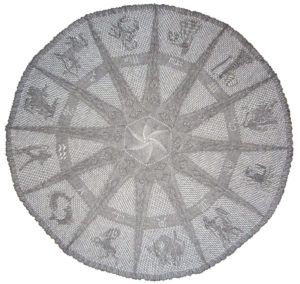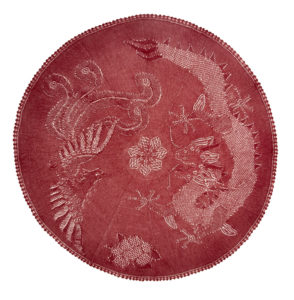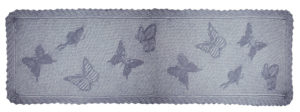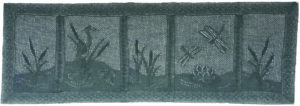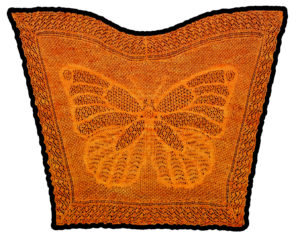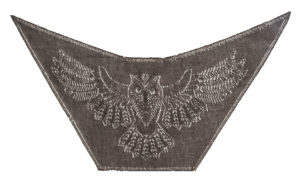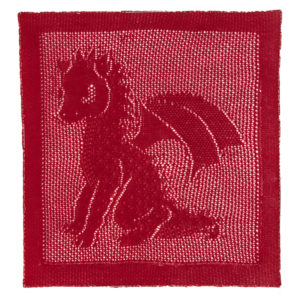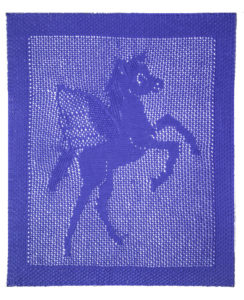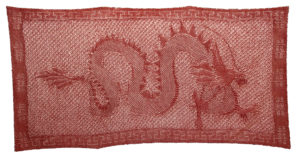I got to interview Sharon Winsauer, Ravelry’s CrazyLaceLady, her lace pictures are the kind of thing I dreamed about when I learned about lace in my 20’s. That exploration with wire needles and mercerized cotton didn’t last long, but I’ve tiptoed back to it now.
How did the ‘picture’ shawls come about?
I don’t wear lace, my idea of dressing up is putting shoes on (to go high- fashion, I put a bra on), but I love to design lace. When I discovered lace, I fell in love with Estonian and Orenburg lace and started collecting stitch dictionaries. Some of the books had stitches that reminded me of feathers or flowers or had some very simplified designs of butterflies and windmills.
After dipping my toes in the water with a few, relatively traditional lace designs, I started thinking (that always gets me into trouble). I love lace, I love dragons, can I design a lace dragon? The result was the Heere Be Dragon Shawl.I never looked back.
Where do your design ideas come from?
Many of my designs are based on my favorite things such as snowflakes, butterflies, and dragons. You can never have too many dragons.
My friend Kathy’s garden inspired one design, while another friend’s cut glass collection inspired two patterns, the Crystal Thistle shawl and the American Brilliant throw(pic). Some designs are based on my husband’s photographs, some from suggestions from customers, and many from “I have no idea under the sun where that idea came from.”
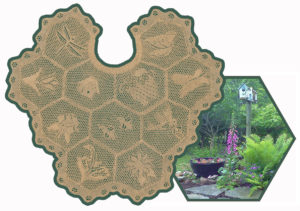
I love your story about the black alpaca yarn demanding to become lace, things talk to me too. What unreasonable demands have yarns been making on you lately?
The yarns have been pretty cooperative lately. However sometimes the designs get very unreasonable. I work up at 2 o’clock in the morning to find 3 cats sitting on my bed.
They said “You’re doing us next.”
I said “ No, I’m not. I working on something else. Besides, I don’t plan on doing any cats.”
“You’re doing us next !!”
Needless to say, cats being cats, Jellico Cats was the next shawl finished.
Sometime the shawls get very insistent on a particular border or background. I am currently working on a 5 paneled shawl of orchids. I am re-doing two of the 5 panels that were almost finished with a different background. It is also insisting on quite an elaborate bottom border with a matching collar. I had absolutely no plans for a collar.
Do you find that you can go from a lace chart right to a sample without much iteration? When I designed the octagons for Ilicium it took me 10 times, but I didn’t know the trick about calculating how many stitches each round should have to lay flat and how that could predict how close I was yet. Several early versions worked nicely as frisbees.
I hate swatching. This often gets me into trouble. I always use multiple stitch patterns and textures. I will sometimes make small swatches testing the stitch patterns to see if they will “work”, especially on sections that will fall in the middle of the work, Even then, I have been known to knit several inches, or full panel and then decide it’s not working. I figure I tink about 2 miles a year. The only pattern I seriously swatched for was the Zodiac.
The figures were on the outer edge of the circle where the rows were approaching 1200 stitches each, so I actually swatched each of the 12 figures ahead of time.
I am a mathematician by training, so I usually come out okay “doing the math” for circular shawls, or changing from a circular to a square or vis-a versa However, there have been a couple of pretty impressive miscalculations ending in some spectacular ruffles.
I struggle with simplification, and abstraction to make motifs knit-able. Do you? How do you deal with it? I’m used to taking an outline and making that be the twist stitch boarder (like a coloring book) then filling it with texture. Do you do something similar for lace? It looks more like what my kid’s homeschool drawing texts call volume drawing where you put down shapes instead of contours.
I don’t use motifs as much as overall pictures. I can’t draw a straight line if my life depended on it and if I try to draw a freeform – it will come out a circle or a square. I work from pictures (or use parts from several different pictures). Sometimes they’re photos, although line drawings, coloring pages and stained glass patterns also make great starting points.
I do all my design work on the computer in Adobe Illustrator (AI). I open a picture in AI, then create a new layer and create a line drawing by tracing. I usually have to modify and simplify the line drawing several times, ending up with a color book type picture.
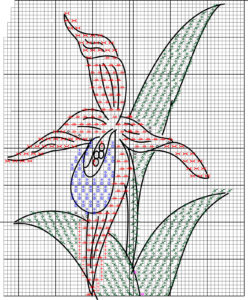
Because the grid on the charts is 1 stitch per square, the drawing need to be adjusted for gauge. I usually increase the height (row direction) of the drawing by about 30 percent. For a circular shawl such as the Imperial Dance,
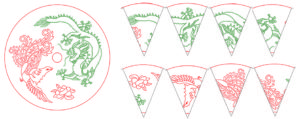
I split the design into 8 pie shaped wedges(pic) before scaling the drawing for gauge.
I then enlarge the drawing to the number of rows and stitches I need for the final item. I generally like to have more stitches rather than less to allow for more detail. My designs are no-fit items (shawls and blankets) so an extra inch or so won’t matter if I need ten more rows or 12 more stitches to make the pattern work.
Once I have the outline drawing to size, I start filling in the sections with symbols for the various lace and texture patterns(pic). AI has the capability of putting symbols for the various sections such as wings, background, scales, a flower, etc. on different layers. This is particularly useful when I change my mind about the stitch pattern I want to use. I can erase and replace one item, such as a wing without destroying the rest of the chart.
Do you make choices about the poses of your animals to make it easier to knit the motif or grade the pattern?
When I can, I select the direction of knit to make things like feathers easier to do. The Butterfly Delight
was knit on the bias so the wings could be mirror images, but the butterflies could flit about at an angles. If the pattern would work best knitting the long rows of a shawl, such as the Tranquil Pond,
I often break it into panels so you are not knitting umpteen hundred stitches per row. In some cases the design itself determines the shape of the shawl such as the owl in Who’s Whooo or the Flutterby Butterfly.
My patterns tend to be challenging – they generally have work on both sides and you basically have to read the charts stitch by stitch. The standing joke among my friends is the my patterns may have lots of pages – however there are never any repeats. I have made an effort to keep the baby blankets a bit simpler by minimizing the work on the wrong side rows.
My patterns are available at
http://www.ravelry.com/stores/sharon-winsauer-designs

